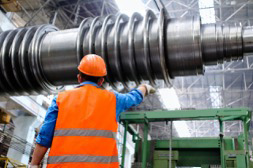Frequent, meaningful recognition could be the key to reversing manufacturing’s growing talent crisis.

By David Bator, Managing Director of Achievers Workforce Institute
The manufacturing industry is facing a massive talent crisis. By 2033, it’s projected that 3.8 million manufacturing jobs will need to be filled to meet the industry’s demand for more skilled workers. Yet, half may go unfilled if companies fail to act now to strengthen their workforce strategy. One major factor behind this looming shortage is the “Silver Tsunami,” which is the wave of Baby Boomers that are set to retire, leaving a significant skills gap across the industry.
While company leaders are right to focus on skills development and automation, one of the most overlooked levers for improving employee retention is far simpler – frequent, meaningful recognition. A recent report from Achievers Workforce Institute (AWI) revealed a critical gap that is fueling the manufacturing sector’s workforce struggles: only 33% of global manufacturing talent say they trust their managers. Without that foundation of trust, even the most dependable teams risk disengagement and costly turnover. Recognition can help close this gap—employees who are regularly recognized by their managers are 19 times more likely to trust them. The call to action for manufacturing leaders is clear: it’s time for a recognition remedy.
Only 24% of manufacturing employees feel meaningfully recognized at work, and just 17% say their manager recognizes them regularly in a way that makes them feel valued. That means 3 out of 4 workers in the industry show up to work every day and leave feeling undervalued and unappreciated for their contributions.
Beyond trust, employee recognition is directly tied to key business results and company culture, including productivity and retention. This gap is a big wake-up call. Simply put, when employees feel valued, they’re not only more engaged, but they’re also more likely to go above and beyond, stay with their employer longer, and recommend their workplace to others – which goes a long way in an industry where reputation is invaluable, and competition is fierce.
The good news? Manufacturing has a solid foundation compared to other industries. Belonging scores are also above average at 29%, and 32% of employees say they can see a long-term future at their company. But under the positives, there lies a warning sign: 13% of employees are actively job hunting. This highlights that even in a traditionally loyal and stable industry, a lack of recognition is pushing skilled workers away and exacerbating the Silver Tsunami’s toll on the manufacturing talent crisis.
When employees go unrecognized, it hurts more than retention—it drains engagement, too. And in manufacturing, that disengagement can be costly. One unmotivated worker could slow down the line, miss a safety check, or contribute to quality lapses that have a ripple effect across production.
Getting an employee recognition program off the ground can feel daunting. The good news is that there’s plenty of science-backed data to help industry leaders get a head start. When done right, the best recognition programs ensure employees receive meaningful and consistent appreciation.
Consistency means recognition happens often. A good goal is to make sure every employee is meaningfully recognized at least once a month. “Meaningful” is the key word here; it means that the recognition is personalized to each individual employee, and the praise shared connects back to the company’s mission and values. For instance, a manager taking a moment to say, “Your dedication to planning lunch for the team every Friday is appreciated and truly embodies one of our core values: caring for one another.” This is more personal and connects the recognition to a greater purpose, and therefore, it has a stronger impact. It’s these moments that can add up to a big cultural shift.
Once the foundation is set, one powerful way companies can elevate their recognition programs is by integrating human-centric innovation directly into the platform. Currently, manufacturing organizations are investing in AI-powered technologies that deliver real-time insights into the transportation of goods, inventory status, and supplier network updates. Imagine applying the same innovative approach to impact a company’s most valuable asset: its people.
By embedding AI into recognition platforms, companies can use analytics to understand what truly resonates with employees and quickly address areas needing improvement. This cutting-edge approach to real-time feedback empowers managers to respond swiftly and build greater trust in leadership, which research shows can increase trust by up to 75%. When AI-driven insights are aligned with company values within its recognition platform, they not only strengthen engagement but also reinforce the behaviors that drive performance and safety.
It’s important for industrial leaders to understand a key mantra, “What gets recognized gets repeated.” If we want to encourage positive behavior and build stronger, more resilient manufacturing teams, we need to make recognition a regular part of the rhythm of work. Manufacturers that find a way to weave recognition into daily operations will not only strengthen employee productivity and engagement but also gain a competitive edge in attracting and retaining skilled talent, at a time when it’s needed most.
About the Author:
David Bator is Managing Director of Achievers Workforce Institute.
Read more from the author:
4 Areas That Determine Whether Managers Are Effective | Forbes, 3/13/25
Healthcare’s Recognition Deficit: Why the Industry Can’t Afford to Overlook Its Workers Any Longer | Healthcare Business Today, 6/9/25
In this episode, I sat down with Beejan Giga, Director | Partner and Caleb Emerson, Senior Results Manager at Carpedia International. We discussed the insights behind their recent Industry Today article, “Thinking Three Moves Ahead” and together we explored how manufacturers can plan more strategically, align with their suppliers, and build the operational discipline needed to support intentional, sustainable growth. It was a conversation packed with practical perspectives on navigating a fast-changing industry landscape.